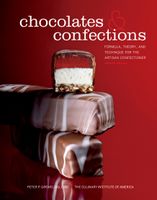Advertisement
Technique Theory: Laminated Candy
Appears in
By Peter Greweling and Culinary Institute of America
Published 2007
Laminated hard candy is a specific and somewhat labor-intensive type of filled candy. While it is traditionally made with caramel and ground nut fillings, the use of flavored hard candy with chocolate filling opens up a world of flavor and color potential. Although making these products well requires some practice, the result is well worth the effort; the uniquely flaky texture is unforgettable.
- MAKE THE FILLING AND KEEP IT WARM. Fillings for laminated hard candy must be extremely low in moisture. In most cases, the filling is made by increasing the viscosity of a fat system, by using a nut paste or chocolate, or by adding confectioners’ sugar, glucose syrup, or both. The filling must have a stiff, doughlike consistency when it is hot or it will not laminate properly with the candy. The filling must remain hot so that it does not cool and harden the candy during lamination.
- COOK THE HARD CANDY. It is traditional to use caramelized sugar to make laminated confections like Leaf Croquant. However, cooked hard candy also works well for this application and has the added advantage of allowing myriad flavors and colors to be used. When hard candy for laminating is formulated, a higher percentage of glucose syrup than usual is added to prevent crystallization through the agitation the candy receives during the repeated rolling and folding.
- COOL AND PULL THE CANDY. With laminated confections like Leaf Croquant, the caramel is not pulled but is simply poured into a rectangle and allowed to firm slightly before applying the filling. Hard candy, if it is used, is lightly pulled to help to accentuate the color and to facilitate more even rolling during lamination. In either case, the sugar should be at a firm but plastic consistency when the filling is folded into it. The filling and the sugar should both be hot and of a similarly malleable consistency.
- LOCK IN THE FILLING. Stretch the sugar into a rectangle approximately 6 mm/¼ in thick. Place the hot filling over half the sugar, leaving a 25-mm/1-in border at the three edges. Fold the sugar over, and seal the three remaining edges around the filling. Sealing the sugar helps to keep the filling enclosed in the candy. If the sugar becomes too firm, place the entire piece in a warm oven until the sugar has softened but not liquefied.
- ROLL AND FOLD THE LAMINATED CANDY REPEATEDLY, APPLYING A TOTAL OF SIX 3-FOLDS. Just as a laminated dough like puff pastry contains many layers of butter and dough, laminated hard candy and its filling are formed into many alternating layers using 3-folds. The temperature of the candy, and therefore the viscosity of the sugar during the folding process, is crucial. Sugar that is too hard will squeeze the filling out the ends during rolling, while sugar that is too soft will tear. The candy must be rewarmed repeatedly during the process, and this is best accomplished while the candy is rolled out and thin, so that it warms quickly and evenly.
- CUT THE CANDY WHILE IT IS WARM. Temperature remains crucial during cutting. If the candy is cut while it is too hot, it will exhibit rounded edges rather than square straight corners. If the candy is too cold when it is cut, the pieces will break apart along the layers of lamination. A sharp knife and the correct temperature ensure clean, even cuts.



